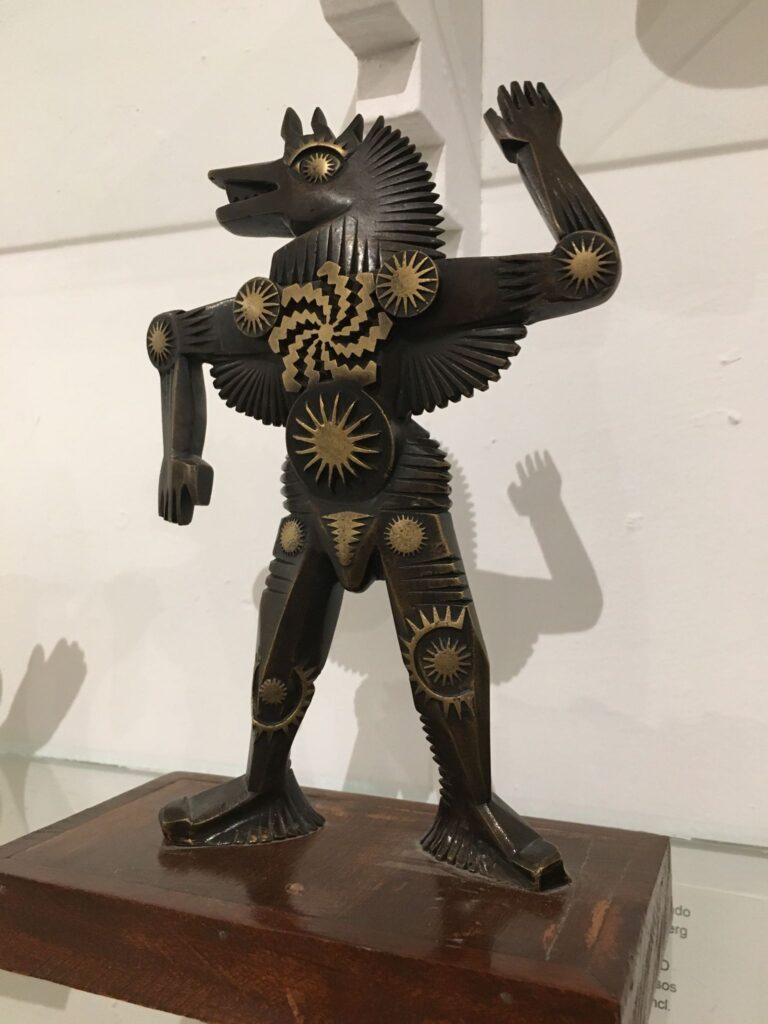
A Surrealistic path from Austin to Mexico City to San Miguel de Allende.
In The Life and Times of Alberto Garcia, I note Dr. Garcia’s probable contact and influence with University of Texas student Anita Brenner. In my last blog post, I described how 17-year-old Anita Brenner’s experience with the occult, perhaps at the home of Dr. Alberto Garcia, caused her to leave the University in 1923, after her freshman year, and return to Mexico. A voice at this séance predicted great things for her in Mexico, and with astounding swiftness the teenaged Brenner made friends with the artistic and political luminaries of the day. Anita over the decades had an immense influence in making the world aware of Mexican art and in securing refuge for those persecuted for their race or their political beliefs.
Mexico City architectural student Pedro Friedeberg during the 1950s worked for Anita Brenner’s magazine Mexico This Month. She encouraged him to quit architecture school and become an artist. A few years later, in June of 1966, she featured him on the cover of Mexico This Month.

The author of the world’s first surrealistic manifesto, André Breton, came to consider Pedro Friedeberg and Frida Kahlo the only two great surrealists in Mexico. Only Pedro survives.

Pedro’s recent comments on architecture perhaps prove the sagacity of Anita Brenner’s career advice:
“I admire everything that is useless, frivolous and whimsical. I hate functionalism, post modernism and almost everything else. I do not agree with the dictum that houses are supposed to be ‘machines to live in’. For me, the house … is supposed to be some crazy place that makes you laugh.”
Architecture degree or not, Pedro Friedeberg in 1961 did design a lotus house for Edward James surrealist compound in the mountain jungles of eastern San Luis Potosi. The roof was lotus-shaped because James instructed Friedeberg that the house “should close during the day because the sun is so hot, and at night it should open so you can see the stars.”

Pedro’s parents were Jews who fled fascism in Europe and arrived in Mexico in 1939. “I was born in Italy during the era of Mussolini, who made all trains run on time. Immediately thereafter, I moved to México where the trains are never on time, but where once they start moving they pass pyramids.”
His mother was a leftist who loved glamour. The gardens of Pedro’s family home in Mexico City were designed by the architect Luis Barragan. He recollects: “At an early age I was influenced by theosophy, Catholicism, atheism, Eastern customs and religions. I was always fascinated by religious architecture: cathedrals, Aztec pyramids, synagogues, Gurdjieffian temples, and so on.” But now he claims no interest in religion. “I’m not really mystical,” he says.
In 1959, Pedro got his first gallery show, at Galeria Diana in Mexico City. Today, Galeria Casa Diana in the colonial town of San Miguel de Allende permanently has his art on display. Before I was aware of Pedro’s prominence and history, I was a regular visitor to this small and beautiful gallery that used to be the residence of him and Diana. It is next door to the entrance to the bull ring that dominates a block near the center of this old colonial town. Coming from the street into the gallery, Spanish colonialism meets Mickey Mouse, 21st Century pyramids, and op art. The space invites transformation. A couple years ago, on the Day of the Dead, I went to the gallery to silently gaze in the eyes of strangers and to be taken blindfolded through a vocal musical improvisation—all organized by a young Burning Man impresario.
This is how Pedro Friedeberg greeted me one time at his gallery.



I once brought Dr. Alberto Garcia’s granddaughter Kay to Galeria Casa Diana. At the time, I was not aware that Anita Brenner had in 1923 been invited to Dr. Garcia’s parties for Mexican students at his home in the south Austin neighborhood of Travis Heights. Nor was I aware of the personal prophecy given to Anita during a séance at the home of Dr. Garcia or some other Austin occultist. And I was not aware of Brenner’s role in encouraging and promoting Friedeberg.

Sources
Brad Rockwell, The Life and Times of Alberto G. Garcia: Physician, Mexican Revolutionary, Texas Journalist, Yogi (2020); Alan Grabinsky, 10,000 Hard-Boiled Eggs and the Art of Pedro Friedeberg At 82, the Mexican artist isn’t done collecting junk in his irrational house, Tablet Magazine (May 4, 2017); Pedro Friedeberg: Inventor of alternative realities (April 12, 2019), https://www.christies.com/features/In-conversation-with-Pedro-Friedeberg-8677-1.aspx; Philip Alvaré, Hands Down, Pedro Friedeberg’s Mexico City Home Is a Surrealist Delight\The eccentric artist’s abode is a veritable cabinet of curiosities, Introspective Magazine (February 16, 2020); Tessel M. Bauduin, Surrealism and the Occult (2014); Patrick Lepetit, The Esoteric Secrets of Surrealism: Origins, Magic, and Secret Societies (2014); Laurinda S. Dixon, review of Guggenheim exhibition Mystical Symbolism: The Salon de la Rose+Croix in Paris, 1892–1897, Nineteenth Century Art Worldwide, Vol. 16 (Autumn 2017).
Official website of Pedro Friedeberg:

